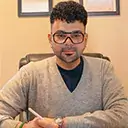Alopecia areata is one of the most common autoimmune hair-loss conditions, yet it often appears suddenly and leaves people confused, anxious, and searching for answers. This guide explains what alopecia areata is, why it happens, early signs to look for, available treatments, and immediate steps you can take today to support hair regrowth.
What Is Alopecia Areata?
Alopecia areata is an autoimmune disorder where the body’s immune system mistakenly attacks healthy hair follicles, causing sudden, round patches of hair loss on the scalp or other body parts.
What Causes Alopecia Areata?
While the exact cause is unknown, several factors increase the risk:
1. Immune System Dysfunction
The immune system targets hair follicles, slowing or stopping hair growth.
2. Genetics & Family History
People with a family history of autoimmune diseases are more prone.
3. Stress & Emotional Triggers
Severe physical or emotional stress can worsen the condition.
4. Other Autoimmune Conditions
Patients with thyroid disorders, vitiligo, or eczema may experience alopecia areata.
Signs & Symptoms of Alopecia Areata
Early signs include:
- One or more round, smooth, hairless patches
- Increased hair shedding while combing/washing
- Tingling or mild pain before hair falls
- Nail changes: ridges, pits, or brittleness
Types of Alopecia Areata
Understanding the type helps determine the proper treatment:
- Patchy Alopecia Areata – Loss in round patches
- Alopecia Totalis – Complete scalp hair loss
- Alopecia Universalis – Hair loss on the entire body
- Ophiasis Pattern – Hair loss along the sides and lower back of the scalp
Is Alopecia Areata Permanent?
In most cases, no. Hair follicles remain alive and can regrow with the proper treatment. Early diagnosis improves recovery and reduces relapse.
Treatment Options for Alopecia Areata
Following treatments should be taken only under the guidance and recommendation of a qualified dermatologist.
1. Topical Medications
- Corticosteroid creams/lotions
- Immunotherapy creams to reduce autoimmune response
2. Injected Treatments
Corticosteroid injections
A dermatologist injects small doses into bald patches to restart growth. Highly effective for mild-to-moderate cases.
3. Oral Medications
- JAK inhibitors (for severe cases)
- Oral steroids (short-term use)
4. Advanced Clinical Options
- PRP (Platelet-Rich Plasma) therapy
- LLLT (Low-Level Laser Therapy)
- Microneedling with growth serums
Home Remedies & Self-Care That Actually Help
While not a cure, these can support hair regrowth:
-
Gentle scalp massages
Stimulates blood flow to follicles.
-
Anti-inflammatory diet
Include omega-3 foods, leafy greens, nuts, and seeds.
-
Reduce stress
Meditation, yoga, deep breathing, or counseling.
-
Avoid chemical or heat styling.
Damaged hair worsens appearance and increases breakage.
Immediate Steps You Should Perform Today
1. Stop using heat tools immediately
Blow dryers, straighteners, curlers → increase breakage around fragile follicles.
2. Take clear photos of the patches
It will help track changes and detect progression.
3. Start a gentle hair-care routine
Use sulfate-free, paraben-free, fragrance-free products.
4. Add scalp-friendly ingredients
Look for products with:
- Niacinamide
- Rosemary oil (clinically shown to stimulate growth)
- Caffeine serums
- Peptides
5. Book a dermatologist appointment
Alopecia areata responds best to early medical treatment.
Can Hair Grow Back After Alopecia Areata?
Yes. Many people experience partial or complete regrowth within months. But the condition may return periodically. Consistent treatment and monitoring are essential.
When to See a Dermatologist Immediately?
- If you notice rapidly spreading bald patches
- If hair is falling out in clumps
- If eyebrows or eyelashes start thinning
- If nails show visible changes
Conclusion
Alopecia areata can be stressful, but it is treatable and non-scarring, meaning hair follicles remain capable of regrowth. With early diagnosis, proper medical care, and supportive lifestyle habits, most people regain healthy hair over time.
Frequently asked question
Alopecia areata is an autoimmune condition where the immune system attacks hair follicles, causing sudden, round patches of hair loss. It usually affects the scalp but may occur anywhere on the body.
Yes. Most cases are reversible because the hair follicles remain alive. With early treatment, hair often regrows within a few months.
Triggers include stress, genetics, immune system disorders, viral infections, and other autoimmune conditions such as thyroid issues or vitiligo.
Dermatologists diagnose it through a scalp examination, medical history, dermoscopy, and sometimes blood tests to rule out autoimmune conditions.
Treatment depends on severity. Common options include corticosteroid injections, topical creams, oral medications, PRP therapy, and lifestyle changes that support regrowth.
Yes. Some people may see more patches appear, especially during high stress or an immune imbalance. Early treatment helps prevent worsening.
In many cases, yes. Hair often grows back in the affected patches within weeks to months. However, some cases may relapse over time.
There is no guaranteed prevention, but managing stress, maintaining a healthy diet, and addressing underlying autoimmune issues may reduce flare-ups.
It varies—some people recover within months, while others experience cycles of hair loss and regrowth over years.
Yes. Because this is an autoimmune condition, professional medical treatment ensures faster regrowth and prevents progression.








